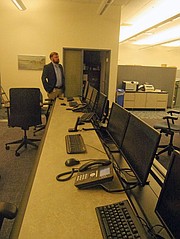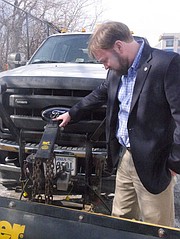Jeff DuVal, deputy director of operations for the City of Alexandria’s Department of Transportation and Environmental Services, indicates an intersection monitored in real time by one of 11 traffic cameras in the Snow Control Center. “On King and Dangerfield we get a pulse for traffic and pedestrians in and out of the metro station,” he said. Photo by Shirley Ruhe/Gazette Packet
It is Thursday before the big snowstorm predicted to hit the D.C. area with up to two feet of snow. The control room is silent and the conference table empty. In a few hours it will become the Snow Operations Center buzzing with an interdisciplinary team of Alexandria City employees focused 24/7 on keeping the city safe. Eleven large screens line the wall hooked to cameras that are recording in real time the major Alexandria intersections and zooming in on a problem area. Other smaller televisions sit side by side on tables crossing the room, each with a specific purpose — checking the temperature of the roads across the city, spitting out up-to-date weather reports and radio dispatch communicating with other agencies and cities across the region.
"We prepare year round for winter weather. In the summer we do table top exercises as well as in-field training and preparation. In the middle of summer it looks pretty funny," said Jeff DuVal, deputy director of operations for the city’s Department of Transportation and Environmental Services.
All of the drivers are sent out on their routes ahead of time and have plenty of time in their zones to become familiar with their own particular speed bumps, cul de sacs, tight areas, pedestrian facilities and potential obstacles. DuVal says many of the drivers have between 15-25 years experience and know their zones like the back of their hand.
Duval says they have 35 snow plows when everything is on the street including 10-12 contractor 10-wheel dump trucks for the larger streets. "And it involves a small army when we all come together — drivers, repair folks, supervisors, administrative staff arranging food, hotel rooms and the logistics of planning the rosters (who works which shifts). This is a team response, not just me. It's all hands on deck," he said. “We have to have an organized system, be able to handle any challenge.
"We are ready and today will start pretreating all primary and secondary roads with brine — like your Thanksgiving turkey. This helps prevent the initial bind of the snow." He adds that it is also very cost effective for a fraction of what it costs to treat with salt. "We watch the weather 24/7 in communication with the National Weather Service in Sterling. We also have access to the D.C. Council of Governments so we speak to other counties and cities."
During the event DuVal said, "We have central conference calls multiple times before, during and after the event with the governments in the region. That way another jurisdiction can request resources if needed. "It is in everyone's best interest to have this be a regional response."
When the storm hits they will start with the primary roads like Duke, King, Quaker Lane and Van Dorn that connect with interstates. Then on to the secondary connector roads and finally the residential roads starting geographically with what makes sense close to bus routes, proximity to schools and hospitals. "We work 12-hour shifts, and it is physically and mentally taxing for the drivers to stay on focus for this length of time. Getting enough sleep is important." DuVal will hop around from the Operations Center to driving around the city looking at the conditions for himself, to check on drivers to be sure they are staying warm and being safe.
DuVal says the public can help. Once a snow emergency has been declared it is important that people move their cars off the designated streets. "It is also essential for people to stay home to give us room and space. It is particularly difficult in Old Town where there are a lot of cars and space is tight. And there is nowhere to dump over 6-8 inches of snow." They can't put it in the river because of sensitivities about the Chesapeake. He said they have a contractor who moves snow to a dumping site. In addition, it is the responsibility of the property owner for clearing the snow on their property. DuVal said, "When you are out shoveling your property, if you wouldn't mind, it helps if you can clear off a nearby fire hydrant or storm drain."
This year they have a new AVS system that uses GPS to indicate in real time where all of the drivers are currently, where they have been in the past and where salt has been applied. "We learned from Snowmaggedon that we needed to have a more organized and systematic response across agencies. We are in a better place than 2009-10,” he said.
During the operation DuVal explains two hours can pass like five minutes as 50 decisions are made on the fly. A phone call from a supervisor that a driver has been in an accident, a truck is stuck, a bus is blocking an intersection, a road is blocked by a number of vehicles. "It involves triage and crisis management, quick decision. I have a very dedicated team of professionals who work all hours, day and night and couldn't be prouder of my people." DuVal says he comes from a family of community service. "It is a passion; a labor of love." He heads off Thursday afternoon to City Hall for an afternoon of meetings with the fire and police chiefs , superintendent of schools, city manager where they will be planning for the city overall, when to make a declaration of snow emergency and which events and activities to cancel. Then home to sleep and back at 6 a.m. Friday. "The biggest surprise we have is always the weather. We rely on meteorologists but with all of the technological advances, we're looking into a crystal ball."
Out in the Storm
Saturday, Jan. 22, 11 a.m.
Jeff Duval has been up since 4:30 a.m. when he left his hotel room in Old Town to head to the Snow Control Center in the City of Alexandria Transportation and Environmental Services headquarters. He is currently on Mount Vernon Avenue taking a quick spin around the city to check things out. "I honestly don't know how much snow is out there — maybe 20 inches."
DuVal says, "We are in decent shape on the primary roads. We're starting on the secondary now. Later in the day we'll start the residential. Our goal is to make one lane passable on every road by sometime tomorrow." But he explains to get curb-to-curb snow removal will take the better part of next week.
No accidents on vehicles reported yet, but there have been a handful of snow plows stuck. "We bring in heavy equipment to get them out." He says they are trying to get cars and people to stay home. "People playing in the snow in the street is dangerous. They should stay in warm with their families."
DuVal says, "It is the beginning of the storm so the drivers' spirits are still high. They are still excited. It is the fun part of the storm." But he continues, "give it a couple of days and they start to get fatigued. They are staying in hotels away from their families and eating whatever food we can find. Employee burn-out sets in." He says this is the most difficult part of the operation.
Sunday, Jan. 24, 8:30 a.m.
DuVal is tired but good. He says, "I don't remember what time I went home." The drivers have been working multiple 12-hour shifts but are still in good spirits. DuVal explains It is a major logistical challenge to get 40-50 drivers to hotels and back on the job. Sometimes they use the snow plow — we use anything we can get."
DuVal says, "last night the snow plows were getting stuck and we had to divert resources from plowing to get the other snow plows out." He said the city had to bring in a lot of pieces of heavy equipment from a disaster response contractor — front loaders, backhoes and dump trucks. Many of them are heavy and bulky to move, not like just driving a snow plow down the street. He had called the contractor earlier in the week and had pieces of equipment staged around the city as backup. He said, "These drivers are from Pennsylvania and upper New York and have a lot of experience with big storms. So for us this is a historic snowstorm but their attitude is this is just a little storm."
The day before DuVal saw a lot of vehicles slipping around at the major intersections on the 11 cameras in the Snow Control Center but "no accidents — great." He said he watched a lot of pedestrians slipping around, too, “drinking adult beverages since they didn't have to go to work.” But most people were listening to the advice to stay home. "But the problem today is the snow has stopped and people will want to get out but we still have to be able to work. There is a lot still to do.”


